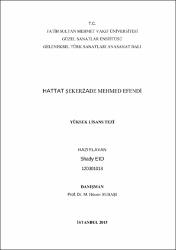Hattat Şekerzade Mehmed Efendi
Künye
EID, Shady, Hattat Şekerzade Mehmed Efendi, Fatih Sultan Mehmet Vakıf Üniversitesi Güzel Sanatlar Enstitüsü Geleneksel Türk Sanatları Anasanat Dalı, Yayımlanmamış Yüksek Lisans Tezi, İstanbul 2015Özet
XVIII. yüzyılda III. Ahmed ve I. Mahmud döneminde yaşamış olan hattat Şekerzâde
Mehmed Efendi, Topkapı Sarayı’nda hocalık yapmış, pek çok talebe yetiştirmiş ünlü bir
sanatçıdır. Şeyh Hamdullah ve Hâfız Osman'ın yolunu takip eden hattat özelikle nesih ve
sülüs hatlarında çok güzel eserler vermiştir. Şekerzâde, önceleri Hâfız Osman’a yakın bir
üslupla yazmış, daha sonra kendine has bir şive ortaya koymuştur.
Bu tez çalışmasında, Şekerzâde Mehmed Efendi’nin hayatı, hocaları ve talabeleri
hakkında bilgi ve belgelerin gün ışığına çıkarılması, bugün mevcut olan eserlerinden
ulaşabildiklerimizin bir araya getirilmesi amaçlanmış, bununla birlikte Osmanlıda ilk matbu
Kur’ân-ı Kerîm ve Osmanlı’da Kur’ân-ı Kerîm hattatlığına verilen değer üzerinde de
durulmuştur.
Ayrıca Şekerzâde Mushafı hakkında Başbakanlık Arşivi’ndeki vesikalar, Osmanlının
Kur’ân-ı Kerîm'e gösterdiği hassasiyet, Kur’ân basımıyla alakalı bazı fikirler ve Osmanlıda
ilk Kur’ân-ı Kerîm’in ne zaman ve nasıl basıldığına dair bilgilere yer verilmiştir.
Şekerzâde’nin sülüs ve nesih ile yazılmış eserleri, bulundukları yerler belirtilerek özel
koleksiyon, müzâyede, kütüphane ve müzelerden ulaşılabilenler ekler bölümünde müsatkil
bir dosyada bir araya getirilmeye çalışılmıştır.
Çalışmamızda ulaşılan en önemli sonuç ise, ilk matbu Kur’ân-ı Kerîm olan Şekerzâde
Mushafı'na dair yaygın bir yanlış bilginin düzeltilmesi olmuştur. Medine’de Şeyh
Hamdullah’ı taklid ederek yazdığı nüshanın, basılan ilk nüsha olmadığı anlaşılmış,
İstanbul’da I. Mahmud’un emri ile yazdığı Süleymaniye Kütüphanesindeki nüshanın matbu
söz konusu Mushaf olduğu ortaya çıkmıştır. XVIII century the calligrapher who lived during the reign of III.Ahmed and
I.Mahmud Shakarzada Muhmmad Efendi, Was a teacher at Topkapi Palace, many of students
have teached by this famous artist. Shakarzada followed the path of the calligrapher Sheikh
Hamdullah and Al-Haafiz Usman's especially in Naskh and Thuluth calligraphy styles and
gave his best works. Shakarzada, at the first wrote with a style close Al-Haafiz Usman's style,
then revealed his own distinctive style.
In this thesis, We tryed to brought all the documents and information which we found
about Shakarzada Muhmmad Efendi's life, teachers and students to light, and tryied to collect
all of his works together which still exicet tell now in this thesis. In the same time , tryied to
talk about the first printed Quran in the Ottoman empire and the value which given to Quran
calligrapher in the Ottoman empire.
In addition, we introduced the documents about Shakarzada's Quran which are keeped
in the Prime Minister's Archive, the sensitivity of the Ottoman Empire about the Quran and
some relevant ideas, the first printed Holy Quran's in the Ottoman empire when and how
printed with the information which we reached about it.
Putting the Thuluth and Naskh works which written by Shakarzada, specifying their
places, in private collections, works which sold in the art auctions, library and museums
accessible and brought together in adds section.
In this study, the most important result achieved is the correction of false information
related to Shakarzada's first printed Quran , the printed copies of Quran was not the copy
which written on the orders of III.Ahmad as understood as a copy similar to the copy of
Sheikh Hamdullah, which keeped in the Prophet's mosque in Medina, but it is the one which
written in İstanbul, on the orders of I.Mahmud which now keeped in Sulaymaniyah library.



















